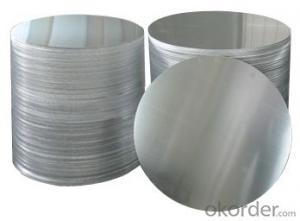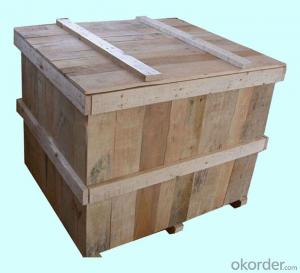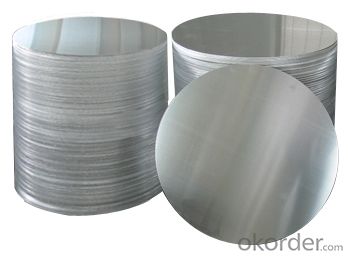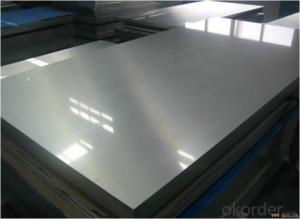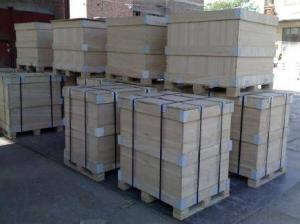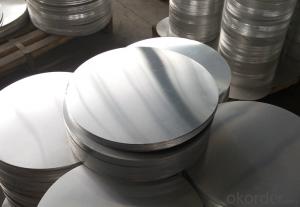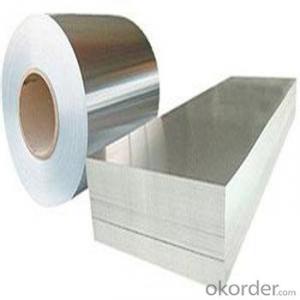China 4 By 8 Sheets of Aluminum - Aluminium Circle for Cookware 1050 1060 1070 3003
- Loading Port:
- Shanghai
- Payment Terms:
- TT OR LC
- Min Order Qty:
- 1 m.t
- Supply Capability:
- 5000 m.t/month
OKorder Service Pledge
OKorder Financial Service
You Might Also Like
Specifications
aluminium circles prices
1.Alloy: 1100, 1050, 1060, 1070, 3003
2. Temper: O, H12, H14
3. Thickness: 0.36mm ~ 5mm
4. Diameter: 120mm - 1000mm
Our company is a leading company in the field of producing aluminum sheet,aluminum plate,aluminum coils,aluminum tap,aluminum foil and other products.we have the hot rolling production line,casting&rolling production line,cold rolling production line,shearing machine,annealing furnace and other equipment.
1.Production Description
aluminium circles prices
Specification | aluminium circles prices | |||||||||||
Alloy: 1050, 1060,1070, 1100, 1200,3003 etc. | ||||||||||||
Temper: O, H12, H22, H14, H24, H26, H18 etc. | ||||||||||||
Thickness: 0.2-200mm | ||||||||||||
Width: Up to 1800mm | ||||||||||||
Length: Up to 6000mm | ||||||||||||
Surface treatment: mill finished, anodized, embossed, PVC coated | ||||||||||||
Feature | Price is much more competitive than that of other series. | |||||||||||
Satisfy regular industrial process of stamping, drawing with good elongation, tensile strength and high formability. | ||||||||||||
Great plasticity, corrosion resistance, electrical conductiviy and termal conductivity. | ||||||||||||
Easy to be welded. | ||||||||||||
Easy to be pressure processed, extended and bent. | ||||||||||||
Application | Sign board, Advertising board, Building decoration, Car body, Cooking utensil, Lamp holder, Fan leaf, Electrical part, Chemical instrument, Machined part, Deep-drawn or spinned part, Welded part, Heat exchanger, Clock surface, Decotation, Reflective instrument etc. | |||||||||||
Alloy | Chemical Component %≤ | |||||||||||
Si | Fe | Cu | Mn | Mg | Cr | Ni | Zn | Ti | others | Al | ||
single | total | |||||||||||
1050 | 0.25 | 0.4 | 0.05 | 0.05 | 0.05 | \ | \ | 0.05 | 0.03 | 0.03 | \ | 99.50 |
1060 | 0.25 | 0.35 | 0.05 | 0.03 | 0.03 | \ | \ | 0.05 | 0.03 | 0.03 | \ | 99.60 |
1100 | 0.95 | 0.05-0.2 | 0.05 | \ | \ | \ | 0.1 | \ | 0.05 | 0.15 | 99.00 | |
1200 | 1.00 | 0.05 | 0.05 | \ | \ | \ | 0.1 | 0.05 | 0.05 | 0.15 | 99.00 | |
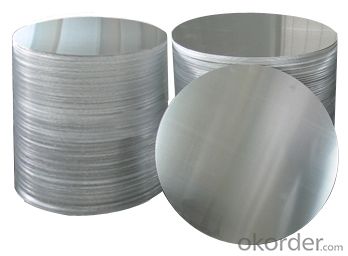
- Q: Are the aluminum sheets suitable for manufacturing architectural roof systems?
- Yes, aluminum sheets are suitable for manufacturing architectural roof systems. Aluminum is lightweight, durable, corrosion-resistant, and easy to work with, making it an ideal material for constructing roof systems in architectural projects.
- Q: How do you join aluminum sheets together?
- To join aluminum sheets together, there are various methods available depending on the specific application and desired joint strength. The following techniques are commonly used: 1. Welding: Aluminum can be welded using gas tungsten arc welding (GTAW or TIG), gas metal arc welding (GMAW or MIG), or laser welding. These processes involve melting the aluminum at the joint and introducing a filler material to create a strong bond. Welding offers excellent strength and durability, but it requires skill and suitable equipment. 2. Riveting: Aluminum sheets can be fastened together using rivets. This technique involves drilling holes through the sheets and using a rivet gun to insert and deform a rivet, creating a secure joint. Riveting is a relatively simple and quick method, but its strength may not match that of welding. 3. Adhesive bonding: Industrial adhesive bonding is a popular method for joining aluminum sheets. Specialized adhesives formulated for aluminum bonding are applied to the surfaces, which then cure and form a strong bond. Adhesive bonding is advantageous as it evenly distributes stress and can join dissimilar materials. However, it may not be suitable for high-temperature or high-stress applications. 4. Mechanical fasteners: Aluminum sheets can be fastened together using screws, bolts, or nuts. This involves drilling holes and using fasteners to secure the sheets. Mechanical fasteners provide good strength and allow for disassembly if needed. However, they may require additional maintenance and can cause stress concentrations around the holes. 5. Clinching: Clinching is a cold joining method where aluminum sheets are pressed together using a punch and die. This process deforms the materials and creates a mechanical interlock, resulting in a strong joint. Clinching is a quick and cost-effective method, although it may not be suitable for thin or highly rigid sheets. Ultimately, the choice of joining method depends on factors such as the required strength, aesthetics, cost, and ease of fabrication. It is advisable to seek guidance from a qualified professional or follow specific guidelines to ensure a successful and reliable joint.
- Q: Can aluminum sheets be used in marine environments?
- Yes, aluminum sheets can be used in marine environments. Aluminum is a commonly used material in marine applications due to its excellent corrosion resistance properties and lightweight nature. It can withstand the harsh conditions of saltwater, making it suitable for boat building, marine structures, and other marine-related uses.
- Q: Aluminium magnesium alloy plate, 5052 aluminium plate, 5005 aluminium plate. 5252 aluminum plate performance and use
- Aluminum magnesium alloy aluminum sheet, also known as 5 * * * series aluminum alloy plate, which represents 5052 aluminum plate, 5005 aluminum plate, 5083 aluminum plate, 5754 aluminum plate, 5A02l aluminum plate, 5A05 aluminum plate and so on. The alloy elements of aluminium magnesium alloy aluminum plate are mainly magnesium, and the magnesium content is between 3-5%. The main characteristics are low density, high tensile strength and high elongation. In the same area, the weight of Al Mg alloy is lower than other series. It is often used in aviation, such as aircraft fuel tanks. It is also widely used in conventional industries. The processing technology is continuous casting and continuous rolling, belonging to the hot rolled aluminum plate series, so it can be oxidized deep processing. In our country, the 5 * * * series aluminum plate is one of the more mature aluminum plate series.
- Q: What characteristics distinguish aluminum sheets from other types of sheets?
- <p>Aluminum sheets are lightweight, corrosion-resistant, and have excellent thermal and electrical conductivity. They are commonly used in construction, automotive, and packaging industries. In contrast, other types of sheets, such as steel sheets, are heavier and stronger but less resistant to corrosion. Plastic sheets are lightweight and flexible but have lower strength and thermal conductivity. Copper sheets offer high thermal and electrical conductivity but are more expensive and less resistant to corrosion than aluminum. Each type of sheet has unique properties that make it suitable for specific applications.</p>
- Q: Aluminum plate thickness 3 mm, what is the allowable error in the national standard thickness?
- Length: + 1mmWidth: + 0.5mmThickness: + 0.02mm, that is, 2 filaments
- Q: How to press multilayer aluminum sheets (aluminum sheet's thickness: 0.2mm) together and keep them inseperate after pressing?
- resistance welding is a welding method that pressing the materials to be welded in an area between two poles and switching on current. the current will go through the contact surface and agjacent area, producing resistance heat effect which will heatthe materials into melting or plastic state and make the materials be welded together.
- Q: Which is better aluminum or stainless steel?
- stainless steel
- Q: How do you achieve a mirror-like finish on aluminum sheets?
- To achieve a flawless mirror-like appearance on aluminum sheets, a series of procedures must be undertaken to eliminate any flaws and create a sleek, reflective surface. The crucial steps involved are as follows: 1. Surface preparation: Commence by meticulously cleansing the aluminum sheet to eliminate any dirt, grease, or other contaminants. Utilize a mild detergent and water to accomplish this task. Thoroughly rinse the surface and ensure it is completely dry. 2. Sanding: Employ increasingly finer grades of sandpaper or abrasive pads to eliminate any scratches, oxidation, or unevenness on the aluminum surface. Begin with a coarser grit (around 120-180) and gradually progress to finer grits (up to 1000 or higher) to attain a smoother texture. It is essential to sand consistently in one direction to avoid visible scratches. 3. Polishing compounds: Administer a polishing compound or specialized metal polish designed explicitly for aluminum surfaces. Employ a soft cloth or a buffing wheel to apply the polish and work it into the surface. Apply gentle pressure and distribute the polish evenly by executing circular motions. Repeat this step until the desired level of shine is achieved. 4. Buffing: Utilize a buffing wheel, preferably composed of felt or cotton, to further enhance the luster. Apply a small quantity of a high-quality polishing compound to the wheel and meticulously buff the aluminum sheet in a consistent manner. Employ circular motions and maintain an unwavering, even pressure. 5. Final polishing: To attain an impeccable mirror-like finish, employ a specialized aluminum polish or a metal finishing compound. Apply a small amount onto a clean cloth and gently rub the surface using circular motions. This final step aids in eliminating slight scratches or imperfections, augmenting the brilliance of the aluminum sheet. Remember to meticulously cleanse the aluminum sheet after each step to eliminate any residue or excess polish. Furthermore, always adhere to the manufacturer's instructions when utilizing specific polishing compounds or tools as they may provide specific guidelines for optimal outcomes. By diligently following these steps, you can achieve a mirror-like finish on aluminum sheets, transforming them into highly reflective surfaces that are visually captivating and functionally efficient.
- Q: iron-based alloys over aluminum in structural members of bridges and buildings?
- Aluminum generally has a better strength-to-weight-ratio. Steel alloys are still used in some of the parts of a typical aircraft, where tensile strength and toughness are the major considerations, over weight. The landing gear, bolts and pins, hinges, bearings, for example. Steel is used for bridges and buildings, because it's a lot *cheaper* than aluminum, and saving weight isn't nearly as critical as it is in aircraft. Steel is stiffer than aluminum, and It's easier and cheaper to make reliable welds in steel as well. Welding aluminum tends to be time consuming and expensive.
Send your message to us
China 4 By 8 Sheets of Aluminum - Aluminium Circle for Cookware 1050 1060 1070 3003
- Loading Port:
- Shanghai
- Payment Terms:
- TT OR LC
- Min Order Qty:
- 1 m.t
- Supply Capability:
- 5000 m.t/month
OKorder Service Pledge
OKorder Financial Service
Similar products
Hot products
Hot Searches
Related keywords
